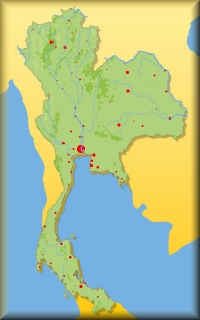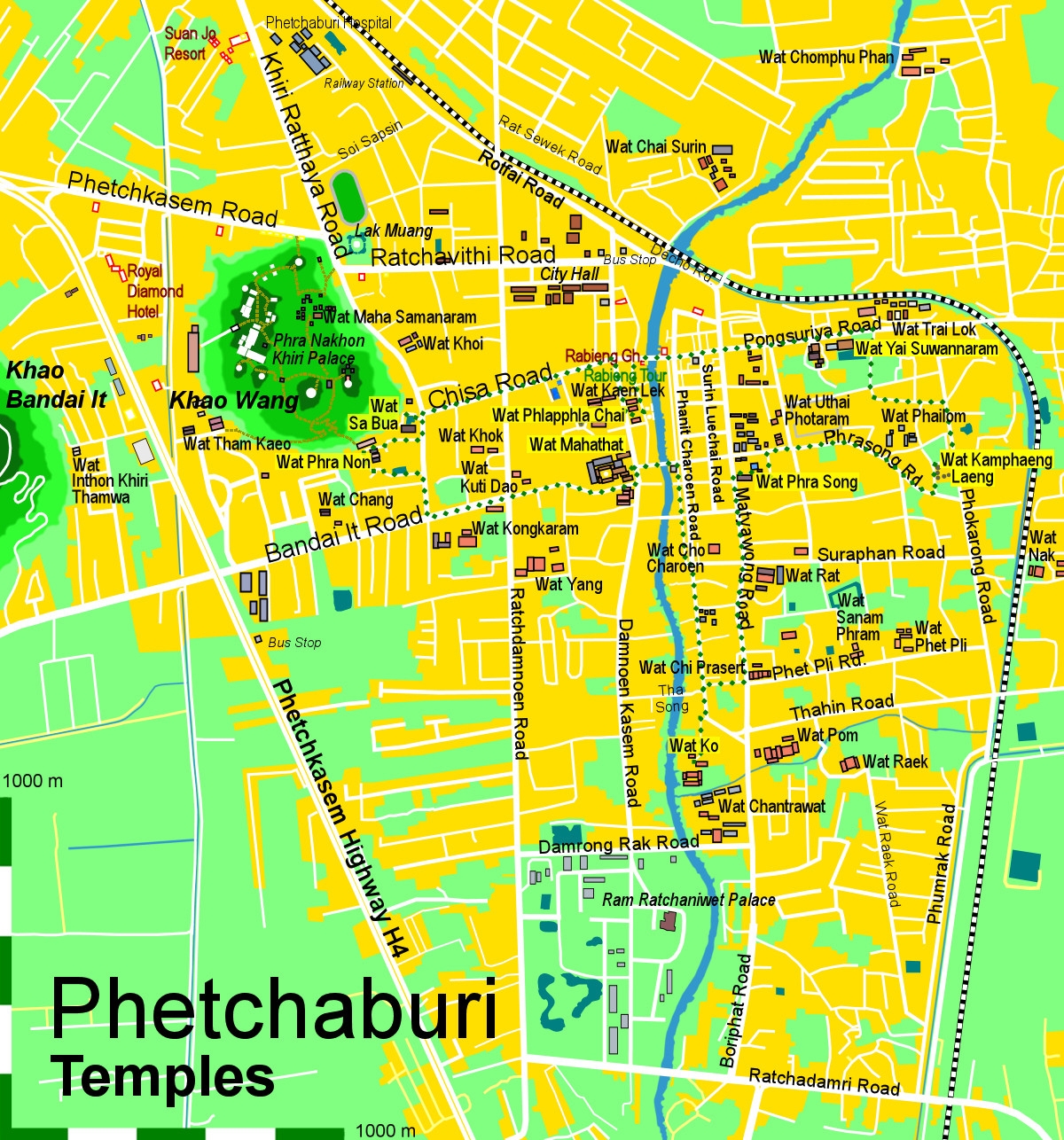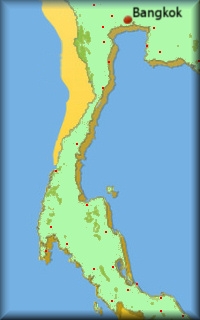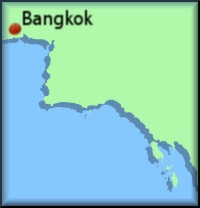 |
A walking Tour to the 8 main Temples of Phetchaburi
Temple >>
Wat Kamphaeng Laeng (Wat Kamphaeng Laeng) (Phetchaburi) 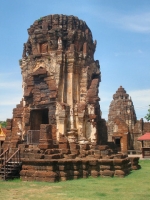 This temple was formerly a Khmer sanctuary in Hinduism, but adapted into a Buddhist temple in the Mahayana Sect and Theravada Sect, respectively. Originally it comprised 5 laterite prang towers; only 4 of them remain at present. It is assumed that each tower was dedicated to and housed an image of a Hindu god; such as Shiva, Visnu, Brahma and Uma. This temple was formerly a Khmer sanctuary in Hinduism, but adapted into a Buddhist temple in the Mahayana Sect and Theravada Sect, respectively. Originally it comprised 5 laterite prang towers; only 4 of them remain at present. It is assumed that each tower was dedicated to and housed an image of a Hindu god; such as Shiva, Visnu, Brahma and Uma. This is based on the fact that an image of the Goddess Uma or Parvati was discovered in a tumbled tower in 1956. When it was adapted to become a Buddhist temple, an ordination hall was constructed. However, the original surroundings were slightly changed as evident from the remaining laterite wall. The five prangs in Wat Kamphaeng Laeng were constructed during the Khmer rule from 1157– 1207. Each of the four preserved towers houses a Brahman deity, presumably Indra, Narain, Brahma as well as Uma, whose statue has been found in the destroyed prang. The old complex made of sandstone has been converted into a Buddhist temple. It is located on Phra Song Road, some 2 kms. from the City Hall. Temple >>
Wat Phra Song (Wat Phra Song) (Phetchaburi) 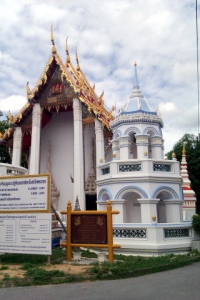 Wat Phra Song is simply a nice temple along the way to Wat Kamphaeng Laeng. It is worth viewing the contemporary stucco work on the mondop’s gable which has been done by one of the masters of the Phetchaburi school, telling the Ramakien, the Thai version of Indian Ramayana. In one scene Todsakan was caught by Phra Rama with assistance of Hanuman, the leader of the monkey army. Wat Phra Song is simply a nice temple along the way to Wat Kamphaeng Laeng. It is worth viewing the contemporary stucco work on the mondop’s gable which has been done by one of the masters of the Phetchaburi school, telling the Ramakien, the Thai version of Indian Ramayana. In one scene Todsakan was caught by Phra Rama with assistance of Hanuman, the leader of the monkey army.Wat Phra Song is situated in the center of Phetchaburi at Matyawong Road. Wat Phra Song is situated in the center of Phetchaburi at Matyawong Road. Temple >>
Wat Koh Kaeo Sutharam *** (วัดเกาะแก้วสุทธาราม -อี๊ด) (Phetchaburi) Wat Koh Kaeo Sutharam is called Wat Koh for short by the locals. The temple was built at the beginning of the 18th century in the late Ayutthaya Period, under the reign of King Boromakos (1732-1758). Formerly, the temple had water all around it. Therefore the precinct and the temple itself appered to be situated on antiques in the temple. It is famous chiefly for the marvelous paintings on the walls of the bot. The ordination hall building is small and made from masonry built on a curved base. There is no window. The decoration at the upper end of the pillar is in the shape of long lotus petals. The ceiling is of different levels decorated by stars carved from wood with painted black and gold leaves. The murals were made from dust colors with the date written BE 2277 (1734 AD). They are still in complete form. The upper part of the murals depicts a group of scholars dressed like foreigners with their hands holding a flower to their chests. On the southern wall, the murial illustrates important places of Buddha's life. Underneath are pictures of westerners on horseback, Japanese monks and Chinese. The pictures demonstrate the relationships of different cultures in the Ayutthaya Period. It is located on Boriphat Street close to the start of Phanit Charoen Street in the south of the town on the East bank of the Phetchaburi River. If traveling from the Nares bridge, the entrance to the temple is on the left. It is located on Boriphat Street close to the start of Phanit Charoen Street in the south of the town on the East bank of the Phetchaburi River. If traveling from the Nares bridge, the entrance to the temple is on the left. Temple >>
Wat Mahathat (Wat Mahathat) (Phetchaburi) 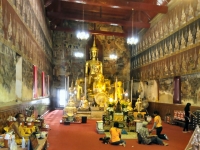 Wat Mahathat Worawihan (its full name) in the city center is more than 1,000 years old. In recent years Wat Mahathat was restored and enlarged. From the outside the prang with its five tall, corn-shaped stupas as well as the chedi with the four-headed Brahma gives an impressive sight. Wat Mahathat Worawihan (its full name) in the city center is more than 1,000 years old. In recent years Wat Mahathat was restored and enlarged. From the outside the prang with its five tall, corn-shaped stupas as well as the chedi with the four-headed Brahma gives an impressive sight.The main hall is painted with scenes from the Ramayana and is used by many people for praying and offering sacrifice. Almost every morning various groups perform temple dances in front of this building. A large monastery area and a school are adjoined to the temple. Temple >>
Wat Phra Non (Wat Phra Non) (Phetchaburi) 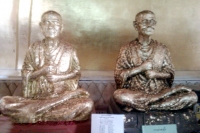 Wat Phra Non (Temple of the Reclining Buddha) is another name for Wat Phra Phuttha Saiyat. It features an impressive 43-meter-long Buddha. It stands at the foot of Khao Wang. Wat Phra Non (Temple of the Reclining Buddha) is another name for Wat Phra Phuttha Saiyat. It features an impressive 43-meter-long Buddha. It stands at the foot of Khao Wang. The temple houses a beautiful reclining Buddha image or Phra Phuttha Saiyat in stucco and brick work, lacquered and covered with gold foil. One of the 4 largest reclining Buddha images in Thailand, it is believed to date back to the middle of the Ayutthaya period. The statue presently enshrined in Phra Wihan (formerly laid outdoors) contains inside many Dvaravati and U-thong Buddha images. Temple >>
Wat Sa Bua (Wat Sa Bua) (Phetchaburi) 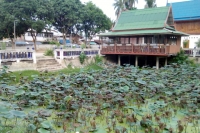 Wat Srabua is one of the oldest temples in Phetchaburi built in the Ayutthaya period. The ancient structure of the temple remains the same as when it was first built. Therefore, if anyone wants to see a specimen of the stucco work at the main Ubosot which was done by artists of the Ayutthaya period, they should come to this temple. Wat Srabua is one of the oldest temples in Phetchaburi built in the Ayutthaya period. The ancient structure of the temple remains the same as when it was first built. Therefore, if anyone wants to see a specimen of the stucco work at the main Ubosot which was done by artists of the Ayutthaya period, they should come to this temple. It is a small symmetrical hall with a curved base. The wall is decorated with pillars. The gable in the east is decorated with stucco in the pattern of Gold Narayana and a giant. The style of the stucco looks like one of the gables in the ordination hall at Wat Yai Suwannaram. The base of the stucco Bai Sema has stones (carved boundary stones) on 4 sides and depicts demons and human beings of 12 nations carrying the Bai Sema. Above the base the second level lines with Garuda and the third level is the ancient Krachang pattern. The fourth level is lotus pattern and on the top stands the big and graceful double Bai Sema. It is located on the eastern slope of Khao Wang hill on Khiri Rathaya Street next to Wat Phranon.
Temple >>
Wat Phlapphla Chai (Wat Phlapphla Chai) (Phetchaburi)  It is one of the old temples worth visiting, not very far from Wat Mahathat. This temple is presumed to have been built in the late Ayutthaya period, A legend is told that in the ancient time, an army camp was once located in the area, therefore a pavilion for the King was built at the edge of the river. Later the temple was built there, and was named after the world Phlapphla, or in English, pavilion of the King. In the center there are superb wood-carved works by artists of the Rattanakosin era. For example, the door panels of ubosot and the main prayer hall and window. It is one of the old temples worth visiting, not very far from Wat Mahathat. This temple is presumed to have been built in the late Ayutthaya period, A legend is told that in the ancient time, an army camp was once located in the area, therefore a pavilion for the King was built at the edge of the river. Later the temple was built there, and was named after the world Phlapphla, or in English, pavilion of the King. In the center there are superb wood-carved works by artists of the Rattanakosin era. For example, the door panels of ubosot and the main prayer hall and window.The door facade of the ordination hall is decorated with stucco done by graceful and distinctive forms of the stucco patterns illustrate different episodes of the Ramayana epic. The panels of the middle window are in the pattern of angels holding double-edged daggers. On the other windows, the carvings are of the lotus patterns. Visitors can also see the Nang Yai Museum shadow plays where nearly 40 pieces are displayed near ubosot. They are all that is left from more than 300 pieces made by Luang Pho Rit, a former abbot, about 100 years ago. The beautiful made puppets are characters in the Ramayana epic. It is located on Damnoen Kasem Road, next to Wat Mahathat and near the Phetchaburi river.
|
New to t-Globe?
Register for free to get the full power of this web site!
Registered members will be able to: |
||||||||||||||||||||||||||||||||||||||||||||||||||||||||||
|
|
